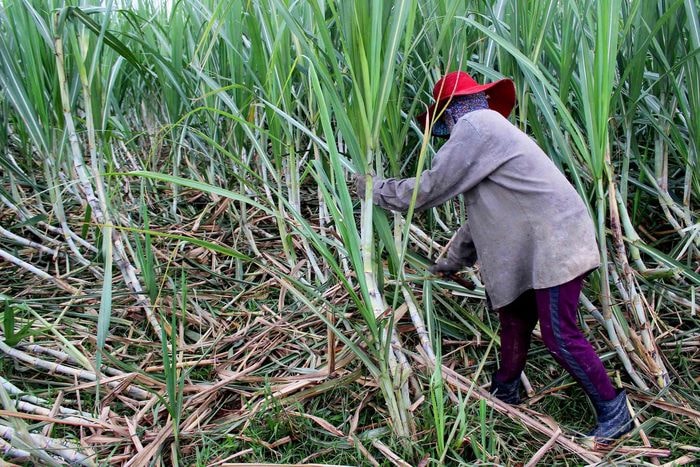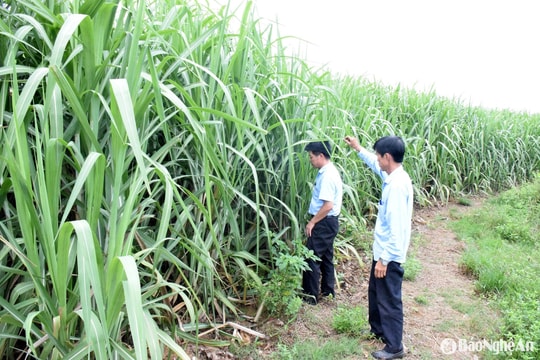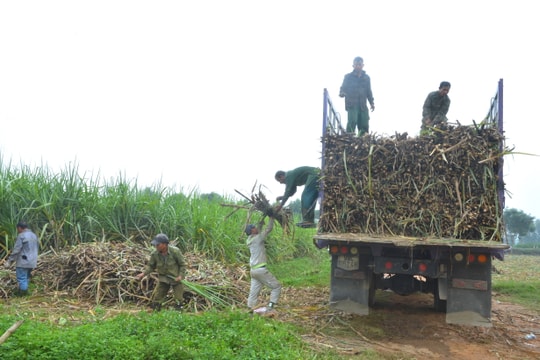Nghe An overcomes broken sugarcane after storm
(Baonghean) -Storm No. 2 caused more than 4,000 hectares of raw sugarcane in Tan Ky district to collapse.After the storm, 40% of the sugarcane area was infected with aphids.
While taking care of her family's sugarcane field, Mrs. Phan Thi Phuc, Hamlet 9, Nghia Dong Commune (Tan Ky) said that after Storm No. 2, her family's entire 5 sao of sugarcane collapsed. With the guidance of agricultural staff of Song Con Sugarcane Joint Stock Company, she cut off the old leaves of the sugarcane plant.
When the soil is dry, she will add potassium and NPK fertilizer to the sugarcane roots to increase sweetness. Up to now, the sugarcane fields have turned green again, the tops are growing strong. As the main income crop of the family, she follows the care process according to the instructions of the agricultural staff.
 |
| Following the instructions of the agricultural officer, Ms. Nguyen Thi Phuc, hamlet 9, Nghia Dong commune, peeled the sugarcane leaves to help the sugarcane stand upright after storm No. 2 knocked it down. Photo: Xuan Hoang |
Mr. Tran Dinh Huong, Vice Chairman of Nghia Dong Commune People's Committee, said: Agricultural officers are more concerned than the people, they are present in the fields every day, monitoring the situation of pests and diseases and the development of sugarcane. When detecting any sugarcane bed with pests, they immediately contact the household owner to spray pesticides in time.
In cases where the owner is absent, the agricultural officer asks someone else to spray the crop and the owner pays the cost later. For poorly developed sugarcane fields, the agricultural officer guides the owner on how to care for and fertilize.
"The recent storm No. 2 caused more than 4,000 hectares of raw sugarcane in Tan Ky district to fall. Immediately after the storm, the Company directed the agricultural staff to increase their presence in the area and guide sugarcane growers on proper care.
Because the sugarcane is in the stage of growing in height, the Company has directed agricultural officers to instruct farmers not to immediately erect the sugarcane, but to cut, beat the leaves, and clear the roots so that the sugarcane can grow again easily. At the same time, drain all the water in the sugarcane field. When the sugarcane has stabilized its roots and base, farmers can apply NPK fertilizer type 11-3-8" - Mr. Nguyen Ba Quy - Deputy Director of Song Con Sugarcane Joint Stock Company said.
The company also warned that after the storm, high humidity in sugarcane fields creates favorable conditions for sugarcane aphids to develop; currently, 40% of Tan Ky's raw sugarcane area is infected with aphids.
To limit aphids in sugarcane fields, after harvest, it is necessary to clean the sugarcane fields, bury them or gather them in piles to burn, especially in areas with severe aphids, clean up around the grass banks,... to reduce aphids' habitat.
Sugarcane should not be used as seed from fields infected with aphids from the previous crop. Sugarcane varieties that are resistant to aphids should be used to incorporate into the planting structure (based on annual monitoring results from varieties grown locally to select recommendations for farmers to use. In reality, the ROC sugarcane group is often less infected with aphids than MY55-14 varieties,...).
Implementing sugarcane planting according to the technical process for each variety and each land area, paying attention to applying enough fertilizer and balancing NPK to help sugarcane grow healthily will increase the ability to resist aphids. Regularly clean weeds, remove old leaves, prune trees to stabilize reasonable density to limit aphids from developing.
When aphids first appear in a small area, you can wear gloves to reduce the density or use a knife, scissors, etc. to cut off the infected leaves and destroy them.
Pesticide application: In case of aphids occurring at high density from level 2-3, which can affect the growth and yield of sugarcane, it is necessary to use pesticides to spray. Use a hand pump or a motor pump; use one of the following pesticides: Anboom40EC, Bassa 50EC; Nibas 50EC, Goldra 250WG, USD Grago 595EC, Dragon 585EC,... mixed with water according to the manufacturer's recommendation. It is also possible to protect natural enemies to kill aphids, such as: ladybugs, spiders, green streak larvae, pintails.
Xuan Hoang



